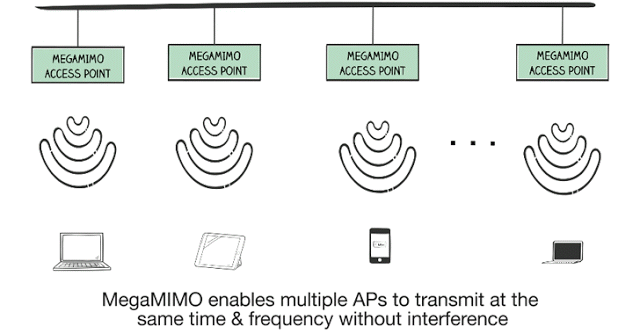A team led by professor Dina Katabi demonstrate a system called MegaMIMO 2.0 that can transfer wireless data more than three times faster than existing systems while also doubling the range of the signal.
The soon-to-be-commercialized system’s key insight is to coordinate multiple access points at the same time, on the same frequency, without creating interference. This means that MegaMIMO 2.0 could dramatically improve the speed and strength of wireless networks, particularly at high-usage events like concerts, conventions and football games.
Experiments found that the system could increase the devices’ data-transfer speed 330 percent.
How MegaMIMO works
The main reason that your smartphone works so speedily is multiple-input multiple-output (MIMO), which means that it uses several transmitters and receivers at the same time. Radio waves bounce off surfaces and therefore arrive at the receivers at slightly different times; devices with multiple receivers, then, are able to combine the various streams to transmit data much faster. For example, a router with three antennas works twice as fast as one with two antennas.
The MIT CSAIL team has a new technique for coordinating multiple transmitters by synchronizing their phases. The team developed special signal-processing algorithms that allow multiple independent transmitters to transmit data on the same piece of spectrum to multiple independent receivers without interfering with each other.
The technology can also be applied cellular networks, meaning that it could solve similar congestion issues for people who actually want to use their phones to make calls. He says the team plans to expand MegaMIMO 2.0 to be able to coordinate dozens of routers at once, which would allow for even faster data-transfer speeds.
SOURCES- MIT, Youtube

Brian Wang is a Futurist Thought Leader and a popular Science blogger with 1 million readers per month. His blog Nextbigfuture.com is ranked #1 Science News Blog. It covers many disruptive technology and trends including Space, Robotics, Artificial Intelligence, Medicine, Anti-aging Biotechnology, and Nanotechnology.
Known for identifying cutting edge technologies, he is currently a Co-Founder of a startup and fundraiser for high potential early-stage companies. He is the Head of Research for Allocations for deep technology investments and an Angel Investor at Space Angels.
A frequent speaker at corporations, he has been a TEDx speaker, a Singularity University speaker and guest at numerous interviews for radio and podcasts. He is open to public speaking and advising engagements.



